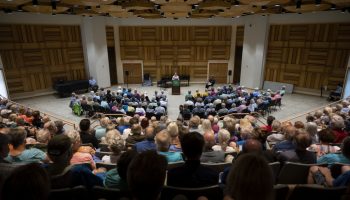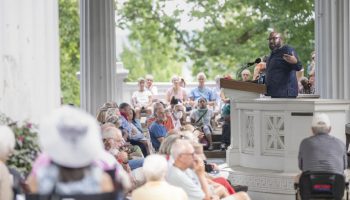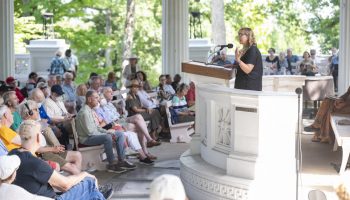
MHARI SHAW/STAFF PHOTOGRAPHER
Archaeologists are impacted by the time in which they live, and in that time, they do two important things.
“One, decide where we want to excavate,” said Carol Meyers, a field archaeologist and the Mary Grace Wilson Professor Emerita of Religious Studies at Duke University. “And two, how we focus on the things that we found, what things we think are most important.”
Wednesday afternoon in the Hall of Philosophy, as a continuation of Week Three’s interfaith theme, “What Archaeology Tells Us About Biblical Times,” Meyers discussed the city of Sepphoris, in which three cultures managed to live among each other in relative harmony. Her talk was titled “Jews, Christians, and Romans: Multiculturalism at Ancient Sepphoris.”
Meyers first questioned how archaeologists could know of three specific cultures living together so long ago in the same place. She described three texts that answer the question.
The first text derives from a Jewish historian from the first century C.E. named Josephus. In his writings, Meyers said, this historian repeatedly mentioned a Roman presence at Sepphoris and called the city “the ornament of all Galilee.” Meyers also said she thought the city could have been termed an “ornament” because of the stunning mosaics that covered the floors of many of the city’s buildings.
Josephus also called it the “capital of Galilee” under Roman Procurator Felix, which gives archaeologists a clear message that Romans were in Sepphoris.
The second text is the Talmud, the record of ancient rabbinic writing, that refers to a man named Jacob who talked about Jesus with Jews in Sepphoris. Despite the criticism Jacob received for the conversations, the general story provides archaeologists evidence that Jewish people were in Sepphoris.
“What our project.. was interest in was what is the evidence of these possible multiple cultures?” says Meyers.
— The Chautauquan Daily (@chqdaily) July 10, 2019
“And sometimes these are called Jewish Christians, or the first Christians,” Meyers said.
The last text, or texts, are Christian sources. Meyers said that, by the Byzantine period, there are references to a bishopric in Sepphoris, and there wouldn’t have been a bishopric present without a large group of Christians.
Another Christian text tells the story of an unnamed traveler who said Sepphoris was the home of Ana and Joachim, Mary’s parents.
“So Christian tradition certainly weighs in on the importance of (Sepphoris) as a Christian site,” Meyers said.
After providing proof of the existence of the three cultures, Meyers described the location of the site.
“It lies in Galilee, about halfway between the Sea of Galilee and the Mediterranean Sea, between Akko on the coast and Tiberias on the Sea of Galilee,” Meyers said.
Meyers said, through architecture, artifacts and mosaics from the site, there is strong evidence to support the existence of “these possible multiple cultures, multiple religious groups or ethnic groups that are related to the site.”
Beginning with architecture, Meyers discussed a Roman theater in Sepphoris. Most likely built in the late first or early second century C.E. , it would have seated 4,000 to 5,000 people, and it was a vital part of the culture in Sepphoris. This was the only theater, and it entertained its audience with comics, mimes and juggling acts — circus acts.
Another piece of architecture in Sepphoris is a mikvah or a narrow, stepped pool. The mikvah, in Jewish tradition, was known as a small “bathing installation for establishing ritual purity.” Women would use it after a menstrual cycle, for example. Others would use it before particular holidays.
“There were dozens of them; almost one on the basement level of every domestic structure,” Meyers said. “And as a result, if these are firmly — as I think they are — identified as a Jewish structure, there are so many of them under the homes (that make up) the upper city, what does that tell you about who lives in this part of the city? This is, as some people have called it, the ‘Jewish quarter.’ ”
The last architectural structure is a church from the Crusades, “one of the earliest Gothic structures,” dating back to the 12th century. It was built by the Knights Templar, Meyers said, and was destroyed in the 13th century. What is interesting about this church is that there is a remaining architectural fragment with an inscription of an early Christian symbol on it.
“It’s a Chi Rho which, as most of you probably know, is one of the earliest symbols of Christianity,” Meyers said.
This gives archaeologists like Meyers reason to suspect the church was used by Jewish Christians.
“Archaeologists have to interpret what they find,” says Meyers.
— The Chautauquan Daily (@chqdaily) July 10, 2019
There are also numerous artifacts — made of ceramic, metal, stone and bone — found in Sepphoris that serve as evidence for the cultures that resided in the city. Meyers began by discussing pottery.
“Pottery is ubiquitous,” Meyers said. “It’s the most often found object at an excavation … and very few of them are found whole.”
As most people used the same pottery, the artifacts cannot always be placed with one ethnic group or another. However, shards of pottery are sometimes found with inscriptions on them, which gives archaeologists more to work with.
Meyers said one shard of pottery, also termed an astrakhan, had one word on it. The word was Greek with Hebrew script, which strengthens the evidence for the presence of Jewish people in Sepphoris.
Another astrakhan that Meyers discussed was black with two lines of text.
“It’s so broken that we can’t be sure, but a plausible reading is ‘Hail Mary,’ and you know what group to which we would assign that,” Meyers said.
The last astrakhan was a surprise, Meyers said. It was a wine jar handle with a Greek inscription, Greek being the lingua franca of the Roman empire.
Despite the information that can be taken from artifacts, Meyers said mosaics were the most beautiful part, and they covered many buildings in Sepphoris. One of the buildings, the Dionysus Villa, located in the upper city, had a mosaic floor decorated with many of the Greek gods, such as Dionysus and Heracles. There were also Greek words to explain some of the mosaics. Other scenes depicted on the floor include the Nile River and, the most popular piece of the mosaics, a portrait of a woman.

MHARI SHAW/STAFF PHOTOGRAPHER
“We don’t know who she may have been,” Meyers said. “(Is she) the Lady of the Villa Aphrodite, the goddess of love, because there’s a little kind of cupid figure over her shoulder? Or is she Ariadne, who’s the wife of Dionysus? These are only questions for which we — so far — have no answers and probably never will.”
The real question, though, is who does such a villa belong to? Was it a Christian, Jew or Roman?
Despite the Greco-Roman mythological theme, Meyers said many believe the villa to have been owned by a Jewish person because the villa is located on the edge of the “Jewish quarter.” Though a firm answer cannot be given, Meyers said one of her colleagues believes the villa to be Jewish.
“I have to say that one of our orthodox, Jewish colleagues, who’s also an archaeologist, quite firmly believes that it was a Jewish villa with a Greco-Roman mythological floor,” Meyers said.
She then described a second building, the Nile Festival Building, which has a mosaic of the festival; the Nile is depicted as a woman. Meyers’ favorite part features two boys working on a long pole with numbers on it. The pole measured cubits, so the boys are measuring how high the Nile River flooded. Another mosaic depicts Amazons, and, as stated in a Greek inscription on a mosaic in the building, it is understood that a bishop commissioned the construction of the artwork.
The last building is a synagogue, located on the northern edge of the lower city, and it has unusual mosaic floors, Meyers said. First, it is basilical but there is only one aisle — traditionally, there are two aisles separated by a nave. Second, the centerpiece of the floor mosaic is a Zodiac, which derives from the Greco-Roman culture.
Through the buildings and mosaics and artifacts, Meyers said there was enough archaeological evidence to prove that the Romans, Jews and Christians lived in Sepphoris. The next big question was: How did they all get along?
“Well, archaeology can’t really directly tell us that, but I can give you two pieces of evidence that (suggest) they did get along,” Meyers said. “One is that the ancient written sources do not mention any kind of strife among them.”
The second piece of evidence is an ethnographic piece from the 19th century. An English man named Laurence Oliphant, who lived in Haifa for many years, decided to visit a small village on Mount Carmel that had a mixed population of Jews, Christians and Druze, Meyers said. Oliphant wrote that he was struck by “the apparent tolerance and amiability with which all the members of these different religions regarded each other.”





